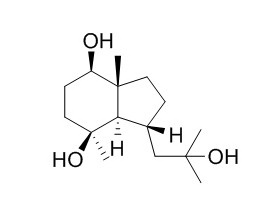Bullatantriol
Bullatantriol has a stimulative effect on significantly proliferation and differentiation of culture osteoblasts. It may have weak antibacterial activities.
Inquire / Order:
manager@chemfaces.com
Technical Inquiries:
service@chemfaces.com
Tel:
+86-27-84237783
Fax:
+86-27-84254680
Address:
1 Building, No. 83, CheCheng Rd., Wuhan Economic and Technological Development Zone, Wuhan, Hubei 430056, PRC
Providing storage is as stated on the product vial and the vial is kept tightly sealed, the product can be stored for up to
24 months(2-8C).
Wherever possible, you should prepare and use solutions on the same day. However, if you need to make up stock solutions in advance, we recommend that you store the solution as aliquots in tightly sealed vials at -20C. Generally, these will be useable for up to two weeks. Before use, and prior to opening the vial we recommend that you allow your product to equilibrate to room temperature for at least 1 hour.
Need more advice on solubility, usage and handling? Please email to: service@chemfaces.com
The packaging of the product may have turned upside down during transportation, resulting in the natural compounds adhering to the neck or cap of the vial. take the vial out of its packaging and gently shake to let the compounds fall to the bottom of the vial. for liquid products, centrifuge at 200-500 RPM to gather the liquid at the bottom of the vial. try to avoid loss or contamination during handling.
Pharmaceuticals (Basel).2021, 14(6):588.
Molecules.2023, 28(3):1313.
Acta Physiologiae Plantarum2015, 37:1736
Plant Physiol.2024, 194(4):2580-2599.
Korean Journal of Pharmacognosy2017, 48(4):320-328
Pharm Biol.2022, 60(1):2040-2048.
Molecules.2020, 25(3):734
Separations2023, 10(11), 567;
Plant Archives2020, 2(1),2929-2934
Elife.2021, 10:e68058.
Related and Featured Products
Phytochemistry. 2008 Sep;69(12):2367-73.
Sesquiterpenoids from Homalomena occulta affect osteoblast proliferation, differentiation and mineralization in vitro.[Pubmed:
18649899 ]
METHODS AND RESULTS:
Chemical investigation of rhizomes of Homalomena occulta (Lours) resulted in isolation and identification of two sesquiterpenoids (6,7), and one daucane ester 8, together with five known sesquiterpenoids, oplodiol, oplopanone, homalomenol C, Bullatantriol, and 1beta,4beta,7alpha-trihydroxyeudesmane. Their structures were elucidated using 1D and 2D NMR spectroscopic and X-ray analyses. The chloroform extract of this plant and compounds 1-7 were tested in vitro for their activities in stimulating osteoblast (OB) proliferation, differentiation and mineralization.
CONCLUSIONS:
Compounds 1-4 had a stimulative effect on significantly proliferation and differentiation of culture osteoblasts, while the chloroform extract and 1 significantly stimulated mineralization of cultured osteoblasts in vitro.
Chem Biodivers. 2007 May;4(5):925-31.
Three new sesquiterpenoids from the aerial parts of Homalomena occulta.[Pubmed:
17511005 ]
METHODS AND RESULTS:
Three new eudesmane-type sesquiterpenoids, compounds 1-3, and eight known constituents, including mucrolidin (4), 1beta,4beta,7alpha-trihydroxyeudesmane (5), 1beta,4beta,6beta,11-tetrahydroxyeudesmane (6), oplodiol (7), Bullatantriol (8), acetylBullatantriol (9), homalomenol (10), and maristeminol (11), were isolated from the aerial parts of Homalomena occulta. Their structures were determined by interpretation of spectroscopic and mass-spectrometric data, and their antimicrobial activities toward six different bacterial strains were tested.
CONCLUSIONS:
Most of the compounds showed weak antibacterial activities in an agar-diffusion assay.
Zhongguo Zhong Yao Za Zhi. 2012 Nov;37(22):3430-3.
Chemical constituents of Acorus calamus.[Pubmed:
23373216]
To study the chemical constituents contained in Acorus calamus.
METHODS AND RESULTS:
The chemical constituents were separated and purified by various chromatographic methods including silica gel, ODS, HPLC and Sephadex LH-20, and their structures were identified on the basis of analysis on spectroscopic data. Ten compounds were separated from A. calamus and identified as 1beta, 4beta, 7alpha-trihydroxyeudesmane (1), Bullatantriol (2), teuclatriol (3), threo-1', 2'-dihydroxyasarone (4), erythro-1', 2'-dihydroxyasarone (5), (+)-de-4'-O-methyleudesmin (6), (+)-de-4'-0-methylmagnolin (7), (+)-eudesmin (8), (+)-magnolin (9) and beta-sitosterol (10), respectively.
CONCLUSIONS:
Compounds 1-2,4-9 were separated from this plant for the first time. Specifically, compounds 1-2,6-9 were obtained from Acorus genus for the first time.



